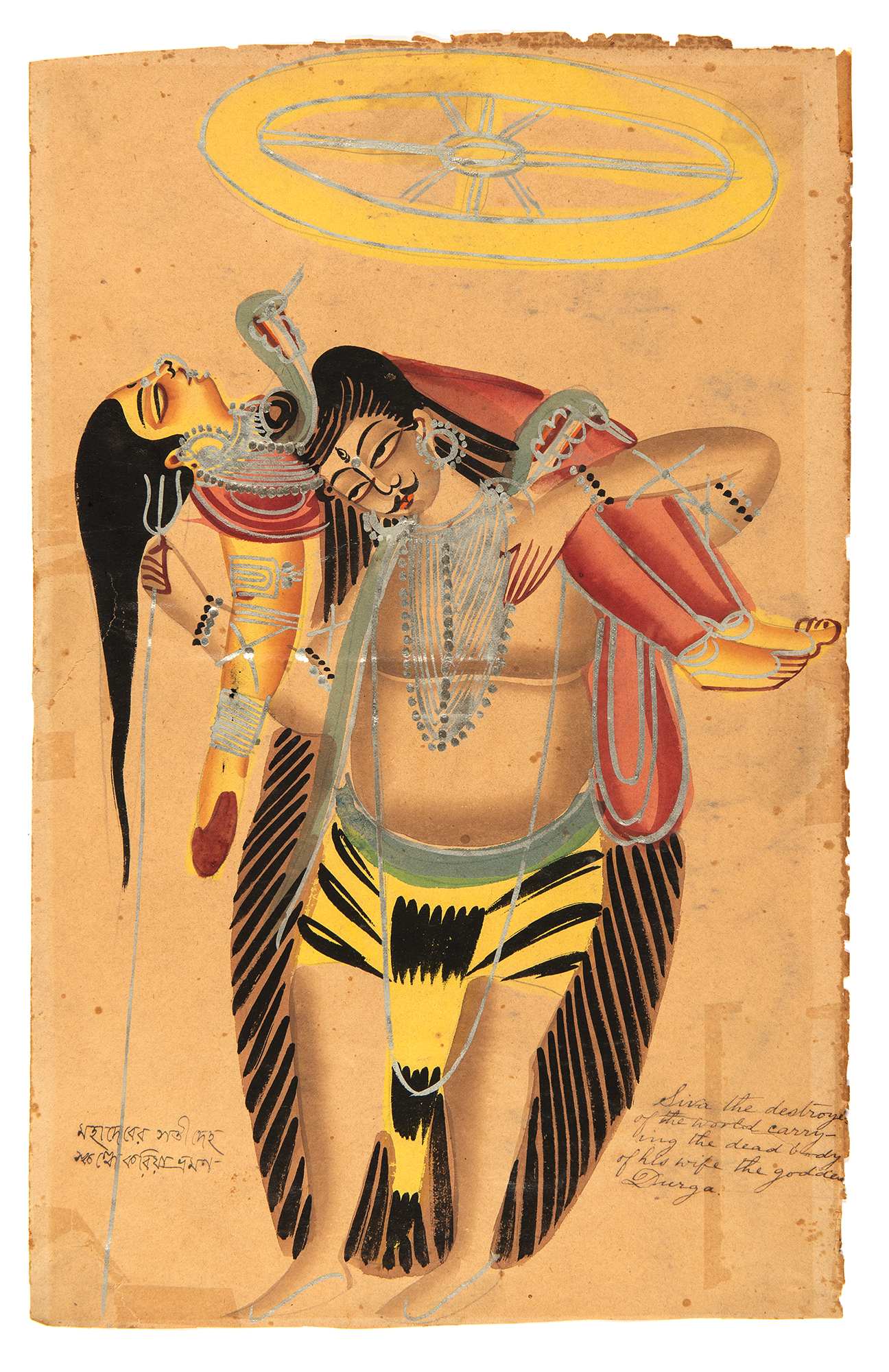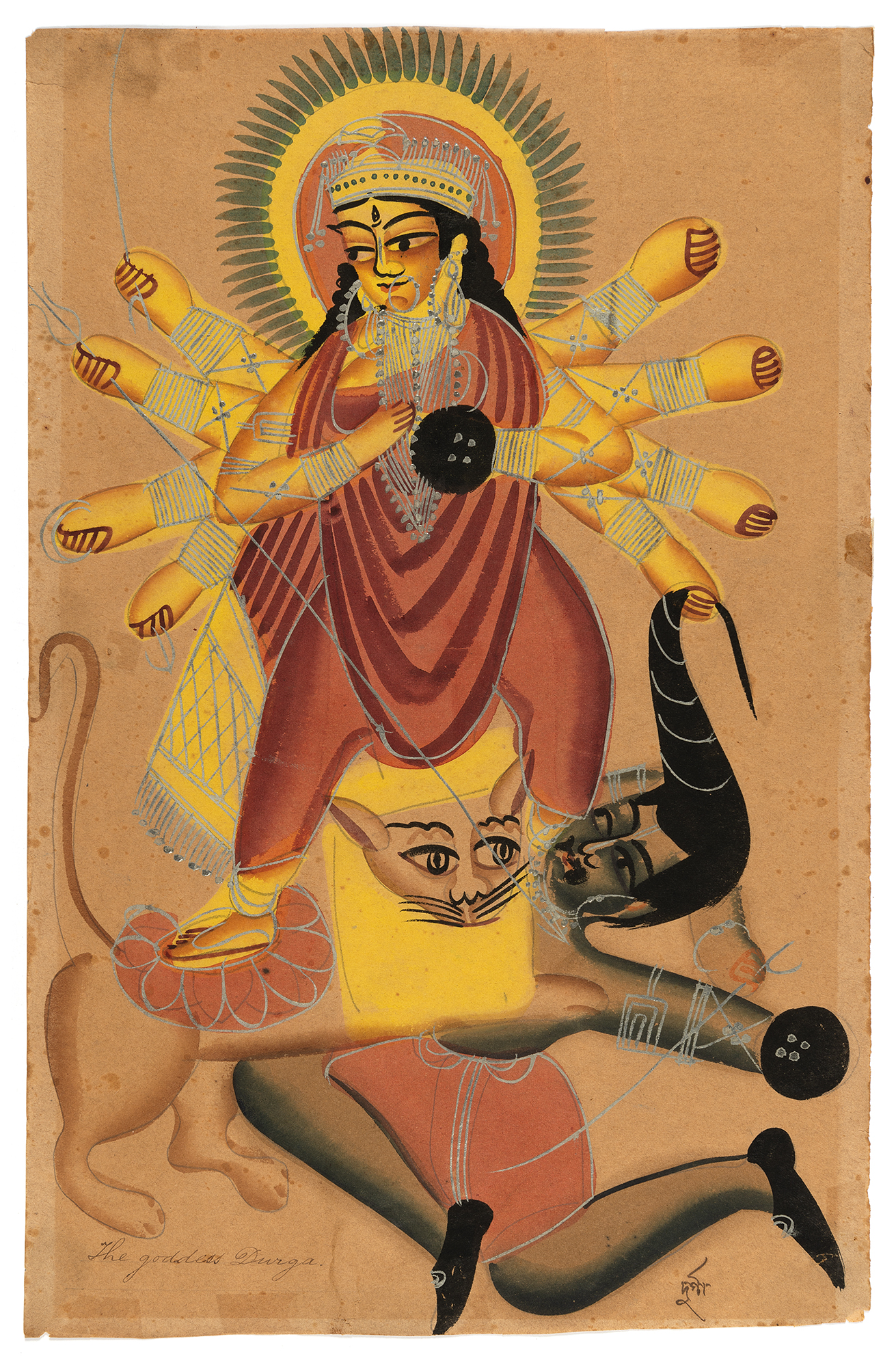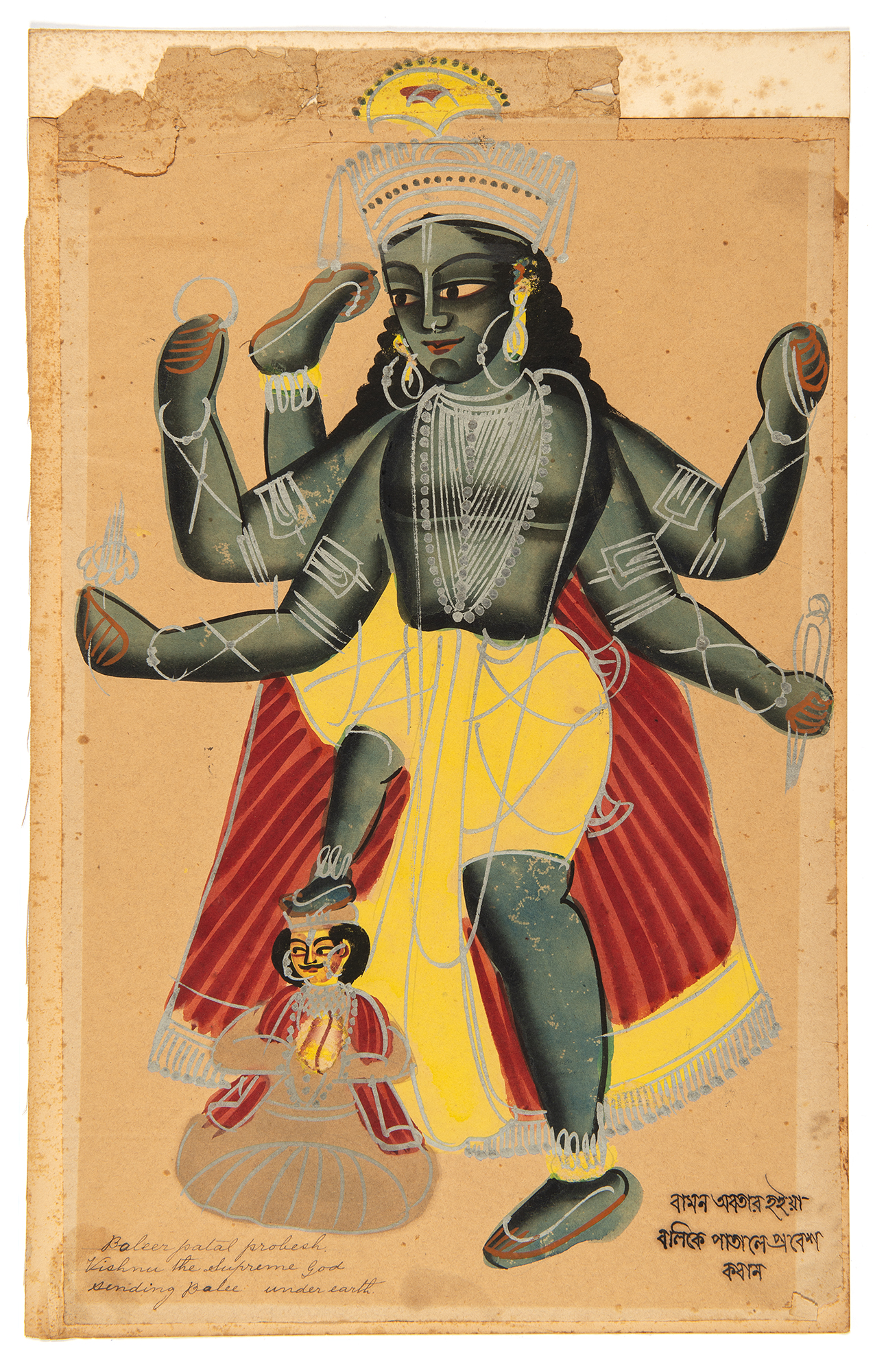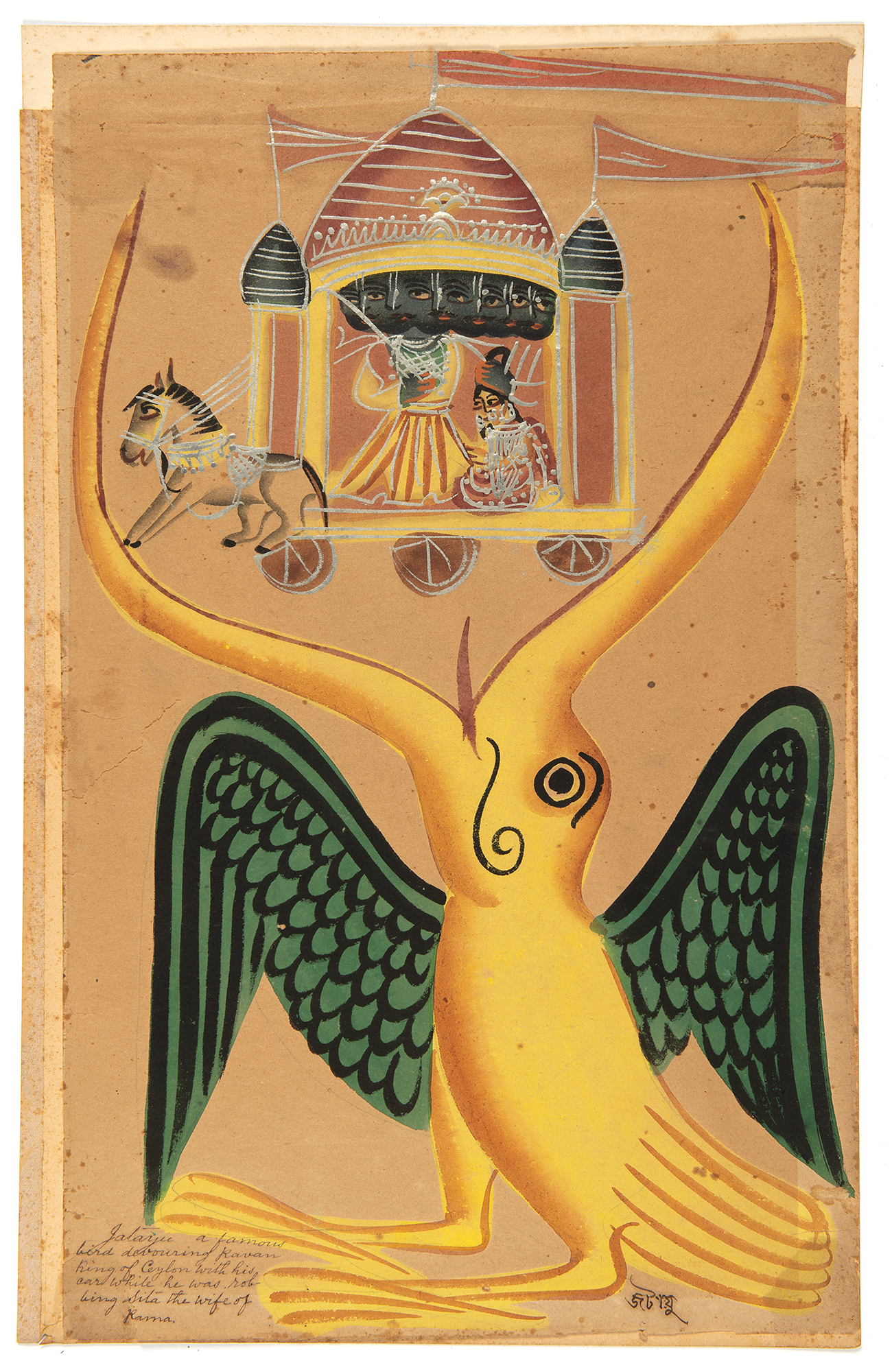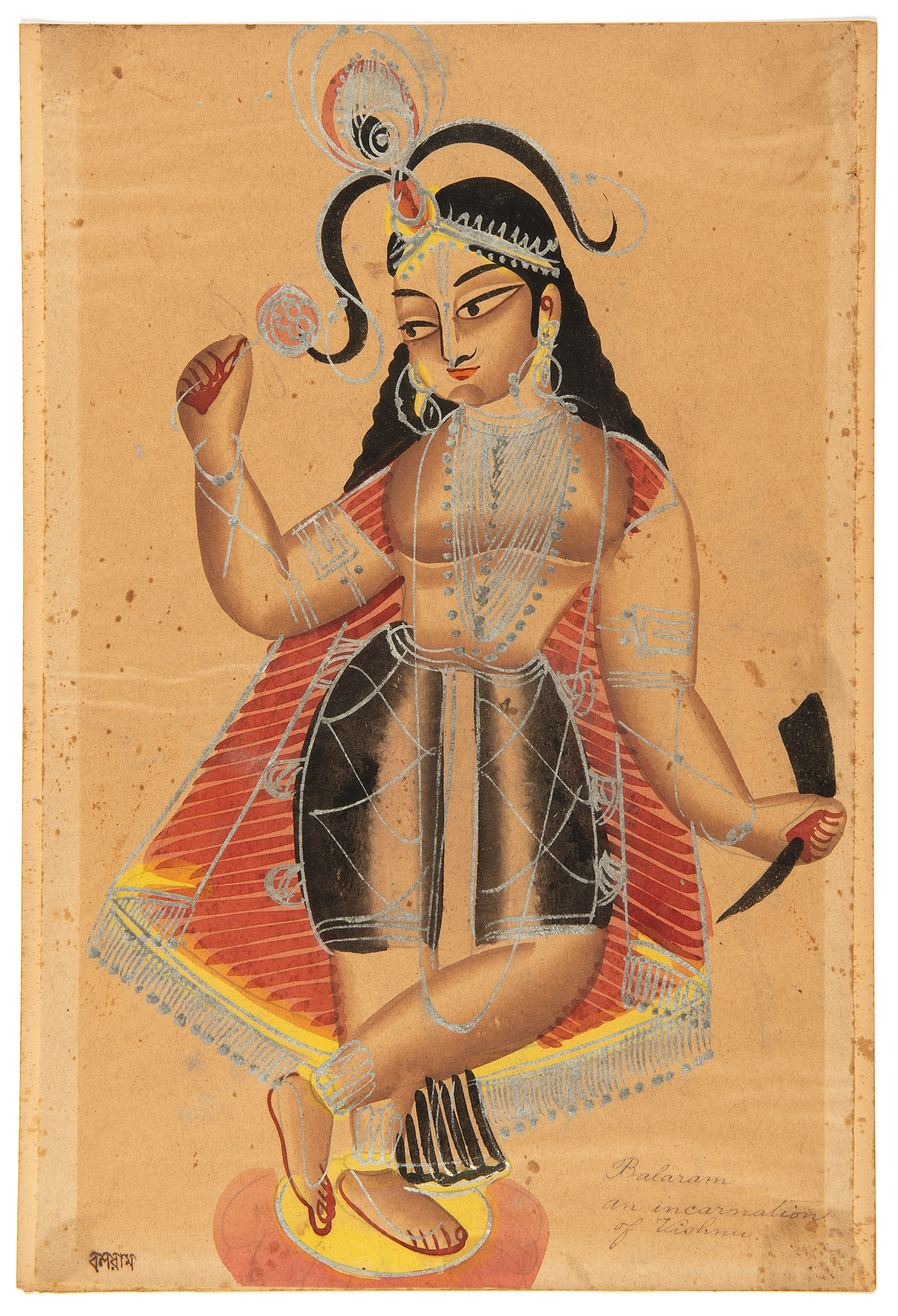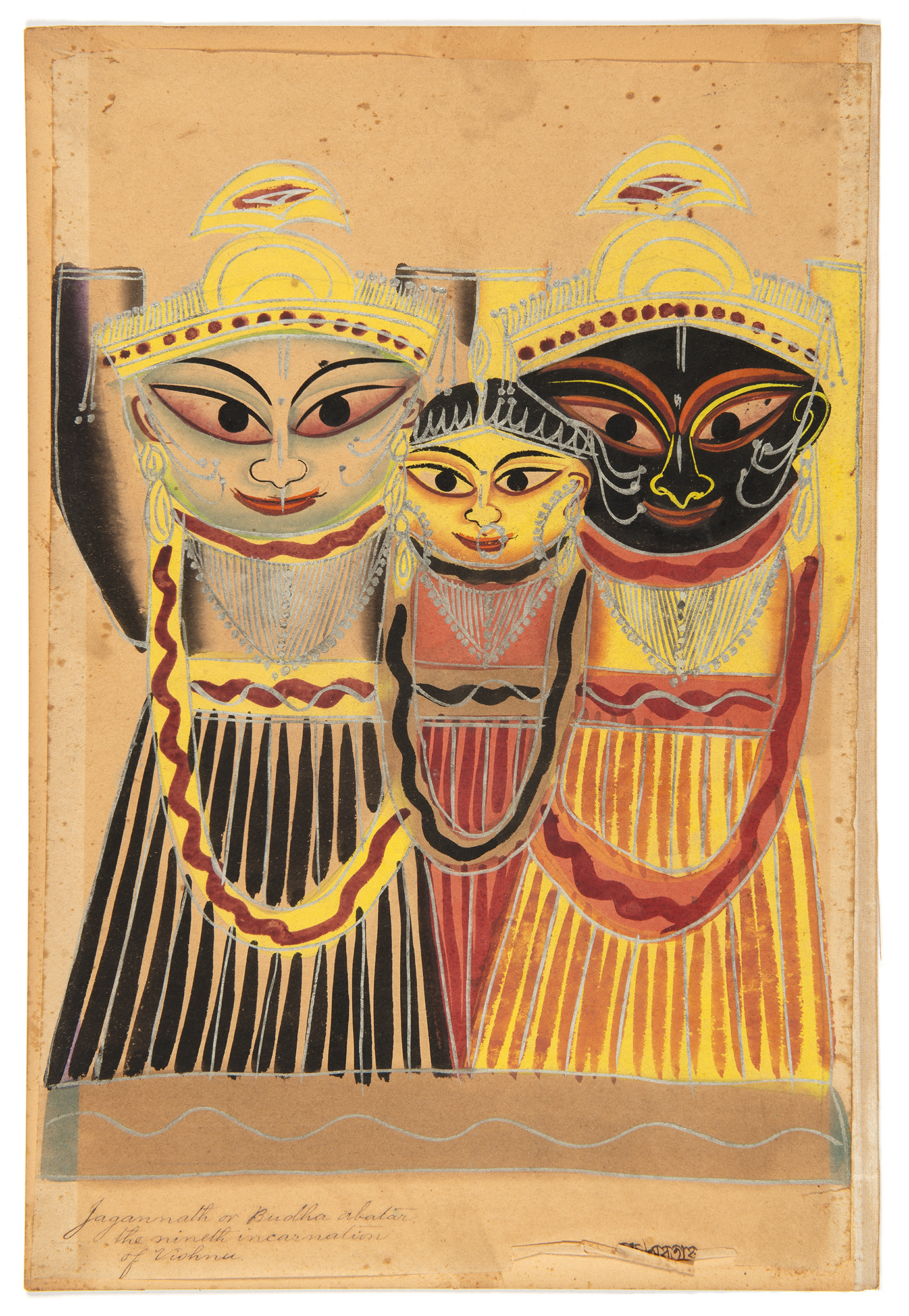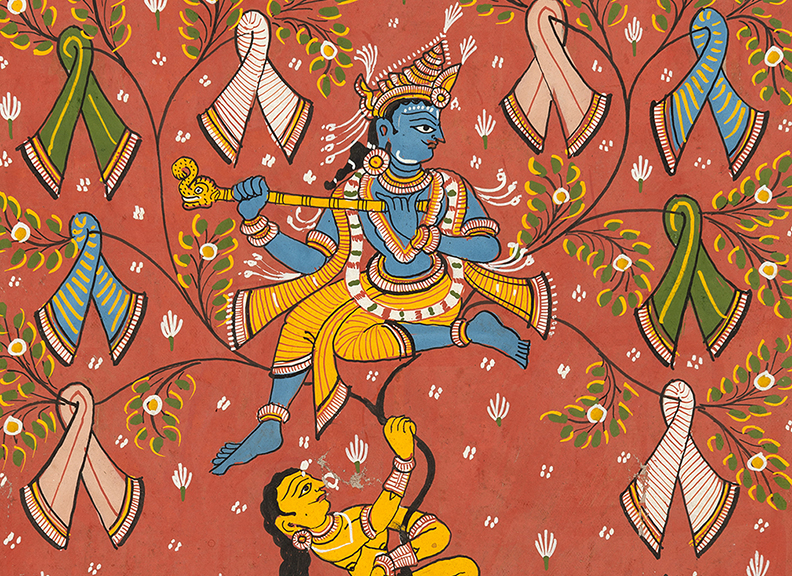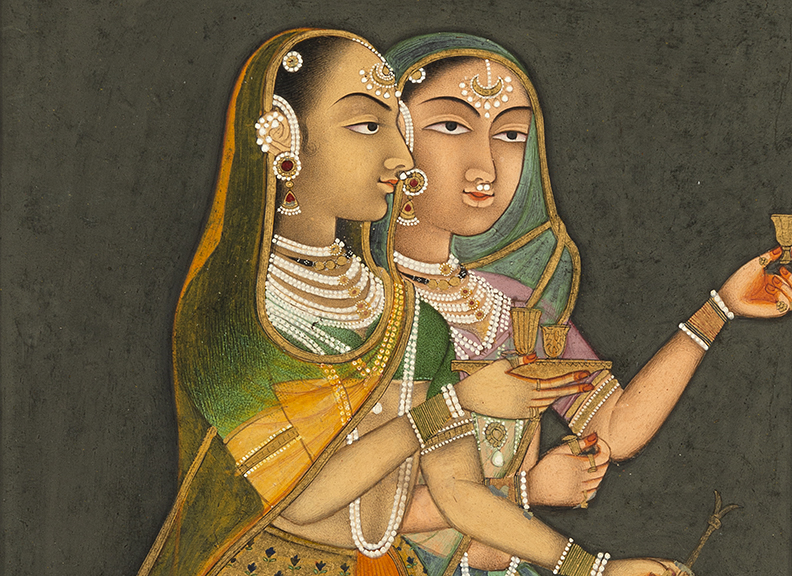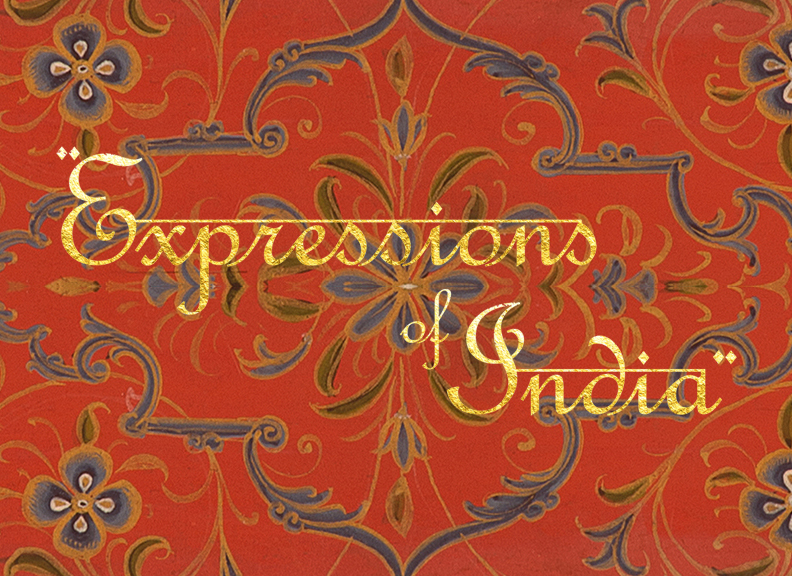If one were to visit Ronald and Catherine Berndt’s residential home in the late 1960’s and further venture into the couple’s sunroom they would have been embraced with a wall of Indian watercolour paintings depicting religious iconography and mythological characters.
Known as Kalighat paintings, works such as these were created in the Kali Temple area on the ghat (bank) of the Burin Ganga canal, in Kolkata (formally Calcutta). Made by the Bengali Hindus of the patua (painter) community, these works were created in the latter half of the 19th Century. Calcutta during this period was a booming metropolis and Kalighat paintings were created and sold as pilgrim and tourist souvenirs to those flocking temples or visiting the British India capital for trade or tourism. These inexpensive, mass produced images, executed with swift brush strokes and bold homemade dyes on mill-made paper, were intended to aid domestic worship and therefore typically depicted Hindu deities and scenes of religious life. With the rise of a Western presence in Calcutta, Kalighat paintings soon developed to reflect the world of the Westernised babus (Hindu gentlemen), with the Kalighat patuas at times using the art form as a powerful instrument of satire – to mock westernisation.
Regardless of their sometimes satirical nature, the Kalighat paintings were popular items with Europeans, who brought the inexpensive works as either curios or as a symbol of Hindu iconography. Christian missionaries also acquired these works to understand the beliefs of their potential Hindu converts, as Hinduism in the Christian faith was considered polytheistic and the idolatrous beliefs depicted in Kalighat paintings evidence of the ‘need’ for conversion. Many Kalighat paintings were hung in Christian churches behind the altar as a reminder of missionary purpose, whilst others were bound in scrapbooks and taken as mementoes back to their missionary homeland. To the Bengali Hindu’s however, the Kalighat served as a powerful testament of their underlying Hindu worship.
For Ronald and Catherine Berndt, the attraction to the Calcutta Kalighat’s was based on the imagery of Hindu iconography, praising the swift executions of the Kalighat patua to reflect the beliefs and attitudes of the Bengali people. Ronald Berndt acquired the collection of Kalighats from an Adelaide antiques dealer around 1963. They were purchased as a set pasted down in a Victorian album, the entirely religious nature of the album suggesting they were collected and inscribed by early Baptist missionaries and brought back to Adelaide as either a memento of missionary service in Calcutta or as an education tool to inform others of this far away religion and its many gods. From here the album spent some time in the hands of the renowned landscape watercolour artist Hans Heysen before they were sold to Mogul antiques of Adelaide, and subsequently purchased by the Berndt’s. Of the original album, ten where acquired by the National Gallery of Victoria and six by the Art Gallery of New South Wales where they remain as part of their collections today.
Ronald Berndt painstakingly removed each Kalighat painting from the Victorian album to breathe ‘new life’ into each work – to Ronald and Catherine Berndt culture was never ‘frozen’ nor ‘dead’ and by displaying the Kalighats in their household for so many years and later bequeathing them to the museum dedicated to their name, was to reignite Bengali 19th century culture and belief. The Berndt’s collection of Kalighat paintings remain an object of study at the Berndt Museum of Anthropology and are one of the largest holdings of Kalighat painting in any Australian public institution.
Hari-Hara
Hari-Hara
1880-1890. Kolkata, India. Watercolour and tin on paper, 46.2 x 30.8 cm. Bequest of RM & CH Berndt, Berndt Museum of Anthropology [1963/0055]
This image depicts Harihara, The Supreme God. Harihara incorporates the two Hindu deities Vishnu (Hari) and Shiva (Hara) to create a single, supreme entity revered by both Vaishnavites and Shaivites. The right-hand side of the figure depicts Shiva, who is illustrated wearing a tiger skin garb and holding a veena (stringed instrument). These attributes, along with the presence of snakes intertwined in a tightly coiled bun positioned high above his third eye indicate that Shiva is both an ascetic and a musician.
On the left is Vishnu, with his yellow dhoti, blue skin and peacock feather crown he symbolizes Krishna, Vishnu’s eighth incarnation. It is difficult to distinguish which attributes Vishnu is holding but it is suggested he is holding a noose in his lower hand and a mace in his upper hand. Both are delicately adorned with silver filigree applied by the patuas (artists) by using tin alloy – a delightful detail that is typical of Kalighat painting.
Philosophically, Harihara is used to represent the unity of Shiva and Vishnu as different aspects of the same Ultimate Reality – Brahman, with depictions of the Supreme God dating back thousands of years. Some of the earliest sculptures of Harihara can be found in the surviving cave temples of India, including the 6th century Badami cave temples in Karnataka, in the southwest of India.
Shiva or Panchanana
Shiva or Panchanana
1880-1890. Kolkata, India. Watercolour and tin on paper, 43.6 x 29.6 cm. Bequest of RM & CH Berndt, Berndt Museum of Anthropology Collection [1963/0030]
Here Shiva appears as Panchanana (Panchana), his fivefold aspect, the destroyer of the world. Shiva’s five heads symbolise that he is the supreme lord of the universe as followed by Shaivites – a major tradition within Hinduism that reveres Shiva as the Supreme Being. Each head represents the five functions that Shiva performs as the Lord of the universe – Srishti (creation), Sthithi (preservation), Tirobhava (concealment), Anugraha (revelation) and Laya or Samhara (destruction) – functions that are also held by Brahma where the Hindu Trimurti (triple deity) of Brahma, Shiva and Vishnu are worshipped. Shiva’s white or grey complexion, achieved by smearing the ashes of corpses on his body, serves as a reminder that all material existence is impermanent, soon to be ash, and that one should rather focus on pursuing spiritual liberation.
Shiva Belaha
Shiva Belaha
1880-1890. Kolkata, India. Watercolour and tin on paper, 43.5 x 29.5 cm. Bequest of RM & CH Berndt, Berndt Museum of Anthropology Collection [1963/0027]
This particular Kalighat celebrates the marriage of Shiva and Parvarti, the goddess of fertility, love, devotion and also determination. In this painting Parvarti is seen to be placing a wedding garland on her soon to be husband Shiva - a depiction of intimate interaction between the divine couple. When Shiva and Parvarti are illustrated together they are typically shown in scenes of tranquil domesticity – either sitting intimately together on a throne or riding atop Shiva’s sacred bull, Nandi – they epitomise marital felicity longed for in Hindu culture. The marriage of Lord Shiva and Princess Parvarti is considered as one of the greatest marriages of all times and is celebrated by some Hindu’s at the Sital Sasthi festival, which also marks the beginning of the Monsoon season in India.
Shiva the Destroyer of the World Carrying the Dead Body of His Wife the Goddess Durga
Shiva the Destroyer of the World Carrying the Dead Body of His Wife the Goddess Durga
1880-1890. Kolkata, India. Watercolour and tin on paper, 43.8 x 27.8 cm. Bequest of RM & CH Berndt, Berndt Museum of Anthropology Collection [1963/0026]
This painting depicts Shiva carrying the body of his wife Sati, the goddess of marital felicity and longevity. The Goddess Sati, meaning ‘virtuous woman,’ is an early incarnation of Parvati, they are considered one and the same. In this image Shiva glumly carries across his shoulders the lifeless body of his dear wife Sati, who has just committed suicide by self-immolation as a result of her father King Daksha’s discontentment to their marriage. In hearing of the loss of his dear consort, an angry and grief-stricken Shiva performs the tandava dance of destruction, consequently wreaking havoc upon the Earth. The legacy of what comes next has many variations in Hindu mythology – some denote that it is during Shiva’s rage ensued tandava dance that Sati’s charred body fell apart and landed on different parts of the Earth, whilst others note that a mournful Daksha spent the rest of his life as a devotee of Shiva carrying parts of his daughter’s body across the country. Other versions describe that Shiva called upon the God Vishnu to return a grief-stricken Shiva back to a position of equanimity. Vishnu used his Sudarshana Chakra to dismember Sati’s lifeless body, with her dismembered body parts falling across various places on Earth. The presence of the chakra above Shiva and Sati in this Kalighat could suggest that the latter version applies to this portrayal. After the night of terror, an all forgiving Shiva restores lives to all those slain, granting them his blessings in the process.
The sites at which Sati’s body parts fell upon the Earth make up the 51 Shakti Peethas and remain major centres of pilgrimage for Hindus.
Ganesha sitting in the Lap of His Mother, Durga the Goddess
Ganesha sitting in the Lap of His Mother, Durga the Goddess
1880-1890. Kolkata, India. Watercolour and tin on paper, 43.6 x 29.6 cm. Bequest of RM & CH Berndt, Berndt Museum of Anthropology Collection [1963/0025]
Seated here is the Goddess Parvati cradling her son Ganesha, the elephant headed god and one of the most widely celebrated gods in the Hindu pantheon. Hindu mythology presents many legends explaining how Ganesha came to have the head of an elephant, the following being a Bengali narration local to the Kalighat region. The legend states, the Goddess Parvati gave birth to an incredibly charming and beautiful child. Delighted with the grace of their newborn son, Parvati and Lord Shiva invited all the gods to celebrate his birth and look upon his splendour. All the gods came to their home at Mount Kailas to bless the newborn, including Shani, the embodiment of the planet Saturn. When it was Lord Shani’s time to bless the child, he refused to look at the boy, as he was cursed with the gaze of destruction. Not knowing his curse, Parvati insisted that Shani look at her beloved child and not wanting to further offend Parvati, Shani obliged, gazing at the boy through the corner of his eye. At his gaze, the head of the boy fell off his neck, rolling away from his body. A horrified and grief stricken Parvati demanded the boy’s life be saved with the replacement of his head. There are different variations as to who was involved in the following events, with some legends denoting that it was either Lord Vishnu or Lord Shiva who retrieved the infant a new head, whilst other mythologies state that it was Lord Brahma who found the head of an elephant and affixed it to the child’s body. The infant was named Ganesha and was blessed as the god of wisdom, remover of obstacles and lord of beginnings.
Ganesha
Ganesha
1880-1890. Kolkata, India. Watercolour and tin on paper, 43.2 x 28.1 cm. Bequest of RM & CH Berndt, Berndt Museum of Anthropology Collection [1963/0017]
This depiction of lord Ganesha seated on a stool with his vahana (vehicle) the rat huddled underneath him is one of the classic Kalighat images that was reproduced by the Kalighat patuas (artists) many times throughout the 19th century. The pot-bellied Ganesha is rich in symbolism, his form and attributes serving as spiritual guides for Hindus. His pot-belly represents generosity and total acceptance, his large ears a reminder to listen more and his small mouth and singular tusk reminders to talk less, retain good and throw away unnecessary evil. In each hand Ganesha holds an article of spiritual importance – In his top right he holds a discus or chakra, the ultimate weapon, in his lower right the padma or lotus blossom, signifying enlightenment and the ascent of the spirit to ever greater heights. In his top left hand he holds a shankha or conch shell, the symbol of victory and fulfilment and in his lower left a club - sometimes portrayed as an axe or lasso – serving as a reminder to not fear obstacles but rather remove them.
By understanding Ganesha’s entire form and his principles it is believed that one can come closer to achieve moksha or liberation.
Durga as Mahishasura-Mardini, the Slayer of the Buffalo Demon
Durga as Mahishasura-Mardini, the Slayer of the Buffalo Demon
1880-1890. Kolkata, India. Watercolour and tin on paper, 43.2 x 28 cm. Bequest of RM & CH Berndt, Berndt Museum of Anthropology Collection [1963/0020]
Depicted here is the Hindu Goddess Durga as Mahishasuramardini, slaying Mahishasura, the buffalo demon. A ten-armed Durga stands triumphant atop her vahana (vehicle) the lion, as she grasps the hair of the buffalo demons true form in one hand, plunging a spear into his heart with another. The goddess is shown holding a weapon in each of her remaining hands. The buffalo demon Mahishasura is known as a deceitful shapeshifter in Hindu mythology, turning into different forms to pursue his evil ways until Durga ultimately slays him. It is interesting in this depiction that Mahishasura is wearing European buckled shoes, a means used by the Kalighat patuas to reflect the British presence in Calcutta during that time.
Goddess Kali in Kalighat Temple
Goddess Kali in Kalighat Temple
1880-1890. Kolkata, India. Watercolour and tin on paper, 43.6 x 29.4 cm. Bequest of RM & CH Berndt, Berndt Museum of Anthropology [1963/0040]
This painting provides an insight into both the origins of the Kalighat practise and the localised beliefs of Hindu society in 19th century Calcutta. It depicts the fearsome Goddess Kali in the temple dedicated to her name, the Kalighat Temple, Kolkata (previously Calcutta). The birthplace of Kalighat painting, the Kalighat temple is also a site of pilgrimage for many Hindu’s as one of the 51 Shakti Peethas – a series of pilgrim destinations in Shaktism worshipped as the sites where the goddess Sati’s (Lord Shiva’s consort) body parts are believed to have fallen upon earth. The Hindu goddess of time and change, Kali is the Goddess Durga in her most terrifying form. Here she is depicted as black skinned, with a protruding tongue, multiple arms wearing a collection of severed human heads around her neck, suggested here by the simplified semicircles around her neck. Her upper right hand is held in Abhayamudra – the gesture of fearlessness, her lower right in Varadamudra – the gesture of giving. In her upper left hand she holds a kharga, or sacrificial axe, in her lower hand the severed head of an asura (demon). She is on one hand a benevolent mother goddess and on the other, a violent, fearsome being.
The Goddess Kali
The Goddess Kali
1880-1890. Kolkata, India. Watercolour and tin on paper, 46.2 x 29.3 cm. Bequest of RM & CH Berndt, Berndt Museum of Anthropology Collection [1963/0016]
This image is a classic portrayal of the Goddess Kali standing atop her husband Shiva. The origin of Kali begins with a ferocious and violent battle between Maa Durga – Kali’s previous state – and the demon Raktabhija. The battle was merciless, with every drop of blood spilled from the demon being replaced with a new one, as ferocious as the previous. Perplexed and enraged by the situation, Durga twitched her eyebrows until Kali was born. The fearsome Kali immediately slayed Raktabhija by sucking the blood of the demon, whose severed head she holds in her lower left hand. In a victorious, blood intoxicated frenzy, Kali continued her rampage, slashing and dancing over the corpses of the slain demons, causing further destruction across the battlefield. Shiva was sent to pacify Kali and did so by laying down motionless amongst the corpses. A blood-intoxicated Kali continued to stagger across the corpses until suddenly she found her husband, Lord Shiva under her feet, stretching her tongue out in shame and embarrassment as she had committed an unthinkably disrespectful act of touching her divine husband with her feet, and so destruction came to an end. This act of stretching out one’s tongue remains a symbol of embarrassment in Hindu culture today.
The God Vishnu as an Incarnation of Tortoise
The God Vishnu as an Incarnation of Tortoise
1880-1890. Kolkata, India. Watercolour and tin on paper, 43.6 x 28.8 cm. Bequest of RM & CH Berndt, Berndt Museum of Anthropology [1963/0053]
This image tells the story of Lord Vishnu as an incarnation of Kurma, the giant tortoise. As Preserver of the Universe, Vishnu descends to the earth assuming different incarnations whenever evil threatens to disrupt order. Kurma avatar is the second avatar of Dashavatara (referring to the ten principal incarnations of Vishnu) and belongs to the Satya Yuga period, explained primarily in the Bahgavad Purana, Agni Purana and Ramayana. Vishnu took the form of the giant tortoise to help the devas (gods) and asuras (demons) and ultimately save the earth from destruction. The devas and asuras were churning the ocean of milk in order to get Amrita or immortality. They were using Mount Mandara as the churning staff yet during this action Mandara begin to sink into the mud at the bottom of the milk ocean. Vishnu took the form of a giant tortoise Kurma and bore the weight of the mountain across his strong, broad back, ultimately saving the devas and asuras and entire earth from destruction. This kalighat is a literal translation of this legend, where an elaborately decorated Vishnu is seen sitting on a lotus above Mount Mandara being held up by a giant tortoise.
Lord Varaha the Third Incarnation of Vishnu
Lord Varaha the Third Incarnation of Vishnu
1880-1890. Kolkata, India. Watercolour and tin on paper, 43.4 x 29.5 cm. Bequest of RM & CH Berndt, Berndt Museum of Anthropology [1963/0058]
This image depicts the battle between Varaha, the boar and incarnation of Lord Vishnu and the asura (demon) Hiranyaksha. Varaha is the third avatar of Dashavatara (referring to the ten principal incarnations of Vishnu) and belongs to the Satya Yuga period where he is depicted either as a complete boar or in the anthropomorphic form with a human body and a boar head, as is depicted in this Kalighat. Varaha appeared after the demon Hiranyaksha had taken the Earth or Prithyi and carried it to the bottom of the primordial waters, sometimes referred to as the ‘Cosmic Ocean’. The battle between Varaha and Hiranyaksha is believed to have lasted a thousand years before the demon was finally slain, as pictured here trapped under the powerful figure of Varaha who holds the demons entrails high above his head in victory. Varaha retrieved the earth from the bottom of the ocean, carrying it between his tusks, and restored it to its place in the universe. It is to be noted that Hiranyaksha is wearing European buckled shoes – a detail which is commonly depicted on the feet of demons across the Kalighat style, reflecting the presence of the British colony and agency of the Kalighat patua to oppose Western civilisation.
Narasimha Rending the Demon Hiranyakasipu
Narasimha Rending the Demon Hiranyakasipu
1880-1890. Kolkata, India. Watercolour and tin on paper, 43.4 x 29.5 cm. Bequest of RM & CH Berndt, Berndt Museum of Anthropology [1963/0057]
This image is a classic portrayal of Narasimha, lion incarnation of Vishnu, disembowelling the asura (demon) Hiranyakasipu. Narasimha is the fourth avatar of Dashavatara (referring to the ten principal incarnations of Vishnu) belonging to the Satya Yuga period where he is presented with a human body and torso and the face of a lion. Hiranyakasipu is the powerful brother of Hiranyaksha who had previously been slain by Vishnu in his fourth incarnation as Varaha, and despised Vishnu for doing so – embarking on an especially vicious tirade persecuting all devotees of Vishnu. Hiranyakasipu had gained special powers by which he could not be killed during day or night, neither inside or outside, not on the ground nor in the sky and not by any weapon used by man or animal. The demon used these powers to viciously condemn the worship of Vishnu is his kingdom, even attempting several times to persecute his own son Prahlada. One evening at dusk (neither day nor night) during Hiranyakasipu’s rampage, Vishnu descends to earth as Narasimha, his half-man, half-lion form (neither man nor animal). He emerges from a pillar in the temple courtyard (neither inside nor outside) and places Hiranyakasipu on his lap (neither on the ground nor in the sky) where he proceeds to disembowel the demon king with his claws (using no weapon). As illustrated, Narasimha holds the entails of the demon king in victory high above his head, restoring calm to earth and faith amongst his followers.
Vamana the Fifth Incarnation of Vishnu Quelling Bali
Vamana the Fifth Incarnation of Vishnu Quelling Bali
1880-1890. Kolkata, India. Watercolour and tin on paper, 46.6 x 29.3 cm. Bequest of RM & CH Berndt, Berndt Museum of Anthropology [1963/0056]
This image tells the story of Vamana, the fifth incarnation of Lord Vishnu stepping on the head of Mahabali, the demon king of heaven and earth. Mahabali in early Hindu mythology is described as a generous but sometimes violent king, who was surround by asura (demon) associates who commonly abused power. Out of trickery, Mahabali had gained Amrita (nectar for eternal life) from the suras (deities) and was thus immortal, fighting many wars which granted him title over heaven and earth. The suras called upon Vishnu to save them from Mahabali’s controlling authority, but Vishnu refused to join the war and kill Mahabali as he was a Vaishnavite (follower of Vishnu). Instead, Vishnu incarnated as Vamana the dwarf, and approached Mahabali, asking him for the ‘three steps of land,’ which Mahabali agreed to. Upon receiving this gift Vamana transformed into Vishnu’s giant form, Trivikrama - depicted in this painting with four arms and three legs holding the attributes of Vishnu in each hand – taking all of heaven with one step and all of earth with his second. Being a devotee of Vishnu, Mahabali offered his own head for Vamana’s third step. Depicted here in the garments worn typically by affluent gentlemen in Calcutta of the time, Mahabali is believed to have been granted a boon with Vamana’s third step whereby he could return to earth every year, his annual homecoming celebrated in the harvesting festivals of Balipratipada and Onam, which have been popular festivals for Hindu’s throughout India’s history.
Parashurama the Sixth Incarnation of Vishnu Slaying his Mother Renuka
Parashurama the Sixth Incarnation of Vishnu Slaying his Mother Renuka
1880-1890. Kolkata, India. Watercolour and tin on paper, 45.3 x 29.3 cm. Bequest of RM & CH Berndt, Berndt Museum of Anthropology [1963/0060]
This Kalighat depicts Parashurama, the sixth avatar of Vishnu, slaying his mother, Princess Renuka. Like other incarnations of Vishnu, Parashurama descends in a time when evil prevailed cosmic order on earth. He descends to earth as a mighty warrior who restores cosmic equilibrium across the earth by slaying the Kshatriya warriors (warrior class of Hindu society) who had begun to abuse their power and tyrannize people with their military strength and weaponry.
This painting however illustrates a particular scene of Parashurama’s life as described in the Bhagvata Purana. Parashurama was born to the Brahman sage Jamadagni and his consort Princess Renuka, a member of the Kshatriya class. One day Renuka went to the river to fetch water where she came across a Gandharva (distinct heavenly being) bathing in the river. She was overcome by desire for the Gandharva, though only for a moment. Jamadagni had suspected Renuka of an unchaste thought and ordered his son’s to cut off her head. The four eldest sons refused to behead Renuka, as the act of killing their mother was considered a great sin, but in denying this act they had greatly offended Jamadagni with their disobedience. Knowing that his father would grant him a boon for his compliance, Parasuma cut off Renuka’s head with his axe as well as slaying his four brothers at his father’s request. As promised, Parasuma was granted a boon and used it to bring his mother and brothers back to life and restore harmony within his family.
The War of Rama, King of Oudh, with His Two Son Lava and Kush
The War of Rama, King of Oudh, with His Two Son Lava and Kush
1880-1890. Kolkata, India. Watercolour and tin on paper, 43.4 x 27.9 cm. Bequest of RM & CH Berndt, Berndt Museum of Anthropology [1963/0043]
This image depicts the battle scene between the great Ramachandra or Rama, the seventh avatar of Vishnu and his two twin sons Kusa and Lava. As described towards the end of the Sanskrit epic, the Ramayana, Sita (wife of Rama) whilst in exile deep in the forest gave birth to twin sons, Kusa and Lava, depicted here wearing simple peach coloured dhoti’s, fiercely pointing arrows at their father. There are variations in the mythology behind why Rama and his sons went into battle, but all are associated with Rama being interrupted by the twins as he is about to perform Ashvamedha, a horse sacrificing ceremony. The sacrificial horse is seen tied to a tree whilst Rama fights his sons. One variation - and the one that best describes this image - details that whilst venturing into the forest, Rama’s sacrificial horse bolts and is captured by Kusa and Lava who refuse to return the horse, initiating a fiery battle with Rama’s aid Hanuman, the monkey king (pictured top left) and eventually Rama himself. In versions of this depiction Rama’s vehicle Hanuman is seen to be holding a tree which he uses as a weapon to fight against the twins, yet it seems in this depiction that Hanuman could be holding one of Rama’s arrows instead. The battle ceases when Rama suddenly realises that he is fighting his sons and the three of them reunite with Sita in harmony.
Hanuman the Devoted and Faithful Servant of Rama Showing in his...
Hanuman the Devoted and Faithful Servant of Rama Showing in his Breast the Images of His Master Rama and His Wife Sita
1880-1890. Kolkata, India. Watercolour and tin on paper, 43.5 x 29.5 cm. Bequest of RM & CH Berndt, Berndt Museum of Anthropology [1963/0054]
Illustrated here is Hanuman, the Monkey God and faithful servant of Rama, showing the image of Lord Rama and his wife Sita in his heart. Hanuman was a great devotee of Lord Rama, the seventh incarnation of Vishnu and main protagonist of the great Hindu epic, the Ramayana. Blessed with superhuman powers, Hanuman rescues Lord Rama and his wife Sita from Ravana, King of Sri Lanka and asuras (demons). When Lord Rama asked what Hanuman would like in return for his brave service, he replies, “I desire nothing, Prabhu (Prince)!” Sita removed a valuable pearl necklace from her neck and offered it to the monkey king, who immediately began to break the pearls apart with his teeth. When a shocked Sita asked what he was doing, he replied that he was eternally grateful for the valuable gift that Sita had given him but he wanted to find if any of the pearls contained his beloved Lord Rama. Hanuman was assured that anything that he wore embodied Lord Rama as his devotion for the divinity was incessant. To prove this Hanuman placed the pearl necklace around his neck and tore open his chest to show both of them enshrined in his heart.
Hanuman the Faithful Servant of Rama Rescuing Rama and his Brother Lakshmana
Hanuman the Faithful Servant of Rama Rescuing Rama and his Brother Lakshmana
1880-1890. Kolkata, India. Watercolour and tin on paper, 43.6 x 29.5 cm. Bequest of RM & CH Berndt, Berndt Museum of Anthropology [1963/0049]
Scenes from the great Hindu epic, the Ramayana, were a popular feature in Kalighat painting, recounting the ventures of Prince Rama, the seventh incarnation of Lord Vishnu. Here we see Hanuman the Monkey God and faithful servant of Rama carrying the prince and his brother Lakshmana across his strong shoulders. In each hand Hanuman carries a club ready to use in battle against the king of asuras (demons), Ravana, who abducted Rama’s wife Sita and held her captive in his island stronghold, Langka (Sri Lanka). Usually painted in black, white or blue, Hanuman is red in this image indicating he is Mahavir, his heroic form. As Hindu mythology states, Hanuman paints his whole body in the vermillion pigment sindur as it promises longevity, the same pigment that Sita applies to her forehead. Atop his head, Hanuman wears an elaborate crown and across his body a web of intricately detailed silver jewellery, confirming his heroic form and superiority as monkey general, leading the battle against Ravana.
Jatayu, a Famous Bird Devouring Ravana, King of Ceylon, with His Car While He was Robbing Sita, the Wife of Rama
Jatayu, a Famous Bird Devouring Ravana, King of Ceylon, with His Car While He was Robbing Sita, the Wife of Rama
1880-1890. Kolkata, India. Watercolour and tin on paper, 46.6 x 29.4 cm. Bequest of RM & CH Berndt, Berndt Museum of Anthropology [1963/0052]
This Kalighat illustrates a scene from the Hindu epic, the Ramayana that was popularly reproduced by the patuas (artists) many times. It depicts the wise, mythical bird Jatayu in his attempt to stop Ravana, the demon king of Langka (Sri Lanka) from kidnapping Lord Rama’s beloved wife, Sita.
According to the legend, Jatayu, the divine bird, was resting in the forest when he was suddenly awoken by the helpless screams of Sita coming from above. He flew up to see Sita tightly bound in Ravana’s flying chariot heading in the direction of the evil king’s palace in Langka (Sri Lanka). The great Jatayu bravely obstructed the path of the chariot in an attempt to stop the abduction. According to Hindu mythology, Jatayu was a devotee of Rama and was willing to save the prince’s beloved wife at any cost, even though he knew he was no match to the many headed, ferocious Ravana. As expected, Ravana threatened to kill Jatayu if he continued to interfere with his task, but Jatayu didn’t back down and instead began thrashing at Ravana with his sharpened talons and hooked beak, all the while chanting Rama’s name. Ravana, who was furious and bloody from Jatayu’s assault began firing at the bird with his diamond studded arrows. He hit one of Jatayu’s frail wings which tore right off, but the bird kept on fighting, desperately trying to free Sita from the wrath of the evil demon king. The battle lasted some time before Ravana took out one last giant arrow and shot it into Jatayu’s other wing, the wise bird stripped of flight, fell to the ground bruised and battered, still calling out the name of Rama as he died.
Krishna the Eighth Incarnation of Vishnu
Krishna the Eighth Incarnation of Vishnu
1880-1890. Kolkata, India. Watercolour and tin on paper, 45.8 x 28 cm. Bequest of RM & CH Berndt, Berndt Museum of Anthropology [1963/0047]
This illustration depicts Krishna, the eighth incarnation of Vishnu, known as the god of compassion, love and tenderness. This is a classic depiction of the popular deity, where he stands in his distinctive fluting pose, playing his flute to melodiously entice the gopis, or milkmaids to dance with him in the moonlight. An intricately decorated peacock crown sits atop his neatly kept hair, his flowing garments beautifully decorated in silver and shaded pigments, contrasting against his deep blue skin. Krishna is one of the most widely revered deities in Hindu culture even standing as a supreme god in his own right, the legends of his life richly represented in Kalighat painting.
Dadhimanthan – Krishna Stealing Butter from His Mother Yashoda
Dadhimanthan – Krishna Stealing Butter from His Mother Yashoda
1880-1890. Kolkata, India. Watercolour and tin on paper, 43.4 x 29.4 cm. Bequest of RM & CH Berndt, Berndt Museum of Anthropology Collection [1963/0035]
Due to Krishna’s popularity as one of India’s favourite Hindu divinities, imagery depicting the scenes of his life were in high demand in Kali (the birthplace of Kalighat painting), where the patuas captured the divine god throughout all stages of his life. Depicted here is a scene from when Krishna was a child (known as Balakrishna), his most mischievous stage. Yashoda, Krishna’s foster mother is pictured busily churning milk to make butter for her family whilst Krishna sneakily steals some butter straight from the mixing pail. Young Krishna with his blue skin and peacock feather crown mischievously plays pranks on his mother to no end, with playful scenes such as this a favourite amongst Hindu audiences.
The Killing of the Demon Putana
The Killing of the Demon Putana
1880-1890. Kolkata, India. Watercolour and tin on paper, 43.5 x 29.4 cm. Bequest of RM & CH Berndt, Berndt Museum of Anthropology [1963/0038]
This illustration depicts Krishna as Balakrishna (childhood self) killing Putana, the rakshasa (demoness) known as the “killer of infants.” Although commonly illustrated playing pranks on his mother Yashoda, Krishna, the eighth incarnation of Vishnu, also performed many miracles and slew demons in his youth. According to Hindu mythology, Putana came to Vraja (previously Gokul), Krishna’s home town, disguised as a young, beautiful woman with a plot to kill the young infant. Stunned by her beauty, Krishna’s foster-mother Yashoda agreed when Putana asked if she could hold her young son and breastfeed him. Putana had smeared her breast with manadana, a deadly intoxicant that would undoubtedly kill young Krishna. Yet instead of taking to her breast, Krishna squeezed her breast, taking away her life as well as the poison milk intended to kill him. In immense pain Putana ran out of Vraja screaming with Krishna still clasped to her breast, until eventually she fell to the ground in silence. Returning to her demonic form after her death, the people of Vraja cut up Putana’s body and buried her bones beneath the earth, burning her skin and flesh as to assure there was no possibility of the demoness returning to their town ever again.
Putana’s evil act of attempting to kill Krishna was overshadowed by offering her breastmilk to the young deity, an act of ‘supreme maternal devotion’ and the reason she is sometimes considered as a foster-mother of Krishna. The legend of Krishna and Putana is narrated in numerous Hindu texts including the Harivamsa (part of the Mahabhrata), the Bhavagata Purana and several other Puranas.
Bastrakaran (Krishna Steals the Garments of the Unmarried Gopis)
Bastrakaran (Krishna Steals the Garments of the Unmarried Gopis)
1880-1890. Kolkata, India. Watercolour and tin on paper, 43.4 x 28.1 cm. Bequest of RM & CH Berndt, Berndt Museum of Anthropology [1963/0044]
This Kalighat is a rather conservative representation of an iconic scene where Krishna, the eighth incarnation of Vishnu, steals the garments of the unmarried gopis (milkmaids). As described in chapter 22 of the Bhavagata Purana, the unwed gopis had taken a vow of asceticism but longed to marry the divine and inimitable Krishna. During the month of Margasirsa (November-December) the gopis would journey to the Yamuna River, singing praise to Krishna as they walked. Aware of their activities, Krishna went down to the river where the gopis were bathing naked in the waters, stealing their clothes that were left on the river bed and climbing to top of a nearby kadamba tree. He laughed and teased at the gopis who were conflicted as to what they should do next – if Krishna refused to return their garments they would tell the king, but if he did, they would become his servants. Unafraid of judgement from the king, Krishna persuaded the cold and shivering gopis to emerge from the water and collect their garments, requesting that they must first join their palms together in a sign of homage to the demigods, who they had risked offending by bathing naked during their vows of austerity. The gopis did as Krishna asked and their garments were returned, and so they became Krishna’s confidantes.
Manvanjan
Manvanjan
1880-1890. Kolkata, India. Watercolour and tin on paper, 43.5 x 29.4 cm. Bequest of RM & CH Berndt, Berndt Museum of Anthropology [1963/0036]
This image captures a tranquil scene between Krishna, the eighth incarnation of Vishnu and his beloved companion, the Hindu Goddess Radha. Krishna is depicted kneeling in quiet deference at the feet of Radha, who is sitting atop an elaborate stool, coyly concealing her face with her veil away from her dearest confidant. Before becoming Krishna’s eternal consort, Radha was the chief of the brij gopis (milkmaids) during the time that Krishna lived amongst the gopa (cow-herders) of Vrindavan. She was the wife of another gopa yet was strongly devoted towards Lord Krishna, and soon became his beloved companion.
The Goddess Radha is highly revered in the Gaudiya Vaishnavism tradition (a Vaishnava Hindu movement inspired by the guru Chairtanya Mahaprbhu) and is worshipped as the goddess of love, compassion, tenderness and devotion. In other Vaishnava movements the goddess is symbolic of the human soul, sometimes even being considered as the feminine embodiment of Krishna himself.
Krishna Slaying the Bird-Demon Bakasura
Krishna Slaying the Bird-Demon Bakasura
1880-1890. Kolkata, India. Watercolour and tin on paper, 43.4 x 29.5 cm. Bequest of RM & CH Berndt, Berndt Museum of Anthropology [1963/0059]
This Kalighat illustrates an iconic scene from the 11th chapter of the great Hindu history the Bhavagata Purana, in describing the childhood pastime of Krishna. Along with detailing Krishna’s playful youth, the text also recounts the multiple demons he faced and ultimately defeated, including the great bird-demon Baraksura as depicted in this image. As legend describes, the cow-herders, including Krishna and his brother Balarama (also an incarnation of Vishnu), would go down to the bank of the Yamuna River daily to allow their calves to drink from the water. After the animals had finished, the boys themselves would take a drink from the river. One day, after drinking, the boys were confronted with a terrifying animal resembling something of a gigantic duck as big as a mountain. The name of the beast was Bakasura, a ferocious demon that had assumed the body of a giant duck with a razor sharp beak. A friend of the perilous Kamsa (Krishna’s evil uncle), Bakasura had come to slay young Krishna, and immediately swallowed the young divinity by the river bank. The cowherds, led by Balarama, having just witnesses this act fell silent, as if they had died. But inside Bakasura’s throat grew an intense burning sensation as he had swallowed Lord Krishna, the father of Lord Brahma, the creator of the universe in the disguise of a child of Nanda Maharaja, a cowherd man. The root of Bakasura’s throat began to burn with such intensity that he disgorged Krishna, who came out unharmed. He immediately began attacking Krishna with his sharp beak, but Krishna, leader of Vaisnavas, grabbed the demon by the two halves of his beak and bifurcated the demon in front of all of the cowherds, as easy as a child splitting a blade of grass.
By defeating the evil Bakasura, Krishna had greatly pleased the demigods of heaven who showered the earth in flowers as a token of their congratulations.
Balarama - Krishna’s Brother and Incarnation of Vishnu
Balarama - Krishna’s Brother and Incarnation of Vishnu
1880-1890. Kolkata, India. Watercolour and tin on paper, 43.5 x 29.5 cm. Bequest of RM & CH Berndt, Berndt Museum of Anthropology Collection [1963/0034]
This image depicts Balarama, the elder brother of Lord Krishna with whom he shared many adventures. In some Hindu legends, particularly in the Vaishnava sect of Hinduism, Balarama is considered one of the avatars of Vishnu in the list of Dashavatar (referring to the ten principal incarnations of Vishnu). Other legends recognise him as the human incarnation of the serpent Shesha – the Naga companion of Vishnu whom comes to Earth in three avatars during different Yuga cycles.
Holding a gada (mace) in his right hand and a plough in his left, Balarama marks the period of evolutionary history where human beings became reliant on agriculture and is known to use these farming tools in moments of battle. He is depicted here standing on a lotus leaf, his right foot raised to suggest dance and music, his fair skin contrasting to the blue complexity of his brother Krishna.
Balarama and His Wife Revati
Balarama and His wife Revati
1880-1890. Kolkata, India. Watercolour and tin on paper, 43.3 x 28.2 cm. Bequest of RM & CH Berndt, Berndt Museum of Anthropology [1963/0051]
This Kalighat depicts Balarama, the elder brother of Krishna, with his dear wife Revati. As described in the great Hindu epic the Mahabharata and Puranic texts the Bhagavata Purana and Vishnu Purana, Revati had travelled from an earlier yuga (time period) to marry Balarama. Revati was the daughter of King Kakudmi, who admired his talented daughter and sought for a divine deity to take her hand in marriage. As Hindu mythology states, Revati and Kakudmi travelled to the abode of Lord Brahma in Brahmaloka with a list of potential consorts appropriate for Revati. Upon hearing their request, Brahma chuckled loudly and explained to a perplexed father and daughter that time ran differently on different planes of existence and that since leaving earth to visit Brahmaloka, 27 chatur-yugas (time cycles) had passed, meaning that none of the candidates listed where still alive. A deflated Revati and Kakudmi were soon comforted with the news that the divine Vishnu was currently on earth in the form of Krishna and his brother Balarama, suggesting that Balarama would be worthy consort of Revati.
As suggested by Brahma, Revati and Kakudmi returned to a completely foreign earth to what they previously knew. Not only had the landscape and environment changed dramatically, but also society and mankind in general. They soon found the divine Balarama and proposed the marriage. Balarama agreed to the proposal on the condition that he could change Revati’s physical stature to reflect that of current society. Because Revati and Kakudmi had come from previous yuga’s, they were far taller and larger than the population currently living on earth. Using the plough depicted in his left hand, suggestive of agriculture, Balarama tapped on the head and shoulders of Revati until she was of the height of his people, where after they celebrated a heavenly marriage.
Jagganath, Balabhadra and Subhadra
Jagganath, Balabhadra and Subhadra
1880-1890. Kolkata, India. Watercolour and tin on paper, 43.5 x 29.5 cm. Bequest of RM & CH Berndt, Berndt Museum of Anthropology [1963/0037]
This Kalighat depicts the Jagganath trio – a triumvirate of regionally identified Hindu deities that are worshiped across parts of India, particularly at the Jagganath temple in Puri, Odisha. Jagganath, lord of the universe, distinguishable by his dark complexion stands alongside his siblings, Balabhadra and Subhadra, the former being his older brother, the later his younger sister. Together, the siblings belong to a particular version of Hindu mythology where they are incarnations or aspects of the divinity Vishnu, the preserver of the universe. Worshipped as a trio, Jagganath is considered an incarnation of Krishna, the eighth avatar of Vishnu and his brother Balabhadra, an incarnation of Balarama, the ninth incarnation of Vishnu with whom he shares many adventures. Subhadra, depicted in the middle of this image, is an avatar of Yogamaya, goddess of illusion (Maya) and wife of Arjuna, a central figure in the Hindu epic, the Mahabharata. Each depicted with large eyes settled in a near symmetrical face, the trio hold their arms high exposing a lack of hands, an identifying feature of Jagganath and his siblings.
Kalki the Tenth and Last Incarnation of Vishnu
Kalki the Tenth and Last Incarnation of Vishnu
1880-1890. Kolkata, India. Watercolour and tin on paper, 43.4 x 29.4 cm. Bequest of RM & CH Berndt, Berndt Museum of Anthropology [1963/0046]
Illustrated in this Kalighat is Lord Kalki, the tenth and final incarnation of the divinity Vishnu. As described in Canto 12 of the Bhagvarta Purana, Lord Vishnu descends to earth in the form of the warrior Kalki, to end the Kali Yuga, the fourth and final era of existence in Hinduism. It is believed that each Yuga has less dharma (moral law driving Hindu behaviour) than the previous, and after 432,000 years, the Kali Yuga was a dark and destructive place which needed to be destroyed in order to restore dharma and calm on earth. The great Kalki descended to earth riding on Devadatta, his noble white steed. In his hand he held a fiery sword that he used to kill the wicked and ungodly that ruled the earth. Amidst the chaos, Kalki ushered in the Satya Yuga – the first era of the Yuga cycle - which replaced the dark and destructive Kali Yuga, ultimately restoring dharma and rejuvenating all existence. Because of this, Kalki is revered as the Lord and Master of Dharma, his prophecy worshiped by Vaishnavas who hold consider Vishnu as the Supreme Lord.
Shitala
Shitala
1880-1890. Kolkata, India. Watercolour and tin on paper, 43.4 x 29.5 cm. Bequest of RM & CH Berndt, Berndt Museum of Anthropology [1963/0039]
This image depicts the Hindu Goddess Shitala (Sheetala), the goddess of smallpox and infectious diseases. Worshiped by many across North East India, including West Bengal, the birthplace of Kalighat painting, Shitala is an incarnation of the Goddess Durga. Depicted here sitting atop her donkey, Shitala is worshipped as the curer of diseases, sores, poxes, ghouls and ailments alike. Shitala, which literally translates to ‘she who is cool’ in Hindi, is depicted here holding the medicinal tools she uses in curing diseases - in her upper right hand she holds a short broom to dust away the spread of disease and in her lower left a vessel filled with either pulses (diseases) or cold water to cool the feverish. In her other hands Shitala holds the items typically held by Durga – a shankha or conch shell symbolic of happiness, and a chakra symbolising duty and righteousness. The Hindu festival Sheetala Ashtami is dedicated to the goddess of smallpox and is celebrated on the eighth day after Holi, the festival of colours.
Lakshmi and Saraswati
Lakshmi and Saraswati
1880-1890. Kolkata, India. Watercolour and tin on paper, 43.4 x 27.5 cm. Bequest of RM & CH Berndt, Berndt Museum of Anthropology [1994/1001]
This Kalighat depicts the two eminent goddesses Lakshmi and Saraswati, who together with Parvati make up the Tridevi, the triad of great goddesses. Depicted on the right is Lakshmi, the goddess of wealth and good fortune. Illustrated in an elegantly flowing red dress as a symbol of fortune and wealth, Lakshmi is the wife of Vishnu, the preserver of the universe. As Vishnu’s wife, Lakshmi takes on various forms to accompany Vishnu’s many incarnations - when Vishnu is the highly revered Rama, Lakshmi is his wife Sita. When he is Parashurama, the axe wielding warrior, she is his loving wife Dharani. The Goddess Lakshmi is worshipped on Diwali, the Hindu festival of lights celebrated annually during the autumn months across India.
Standing alongside Lakshmi is Saraswati (Sarasvati), the goddess of knowledge, learning and the arts, particularly music. Revered as the embodiment of the sacred Sarasvati River, the goddess can be thought of as one of the earlier goddess deities worshipped in Vedic culture, and is the inventor of the Sanskrit language. She is later identified as the consort of the God Brahma, the creator of the universe. As part of the Tridevi, Saraswati, along with Lakshmi and Pavarti, work with the Trimurti of Brahama, Vishnu and Shiva to create, preserve and regenerate the universe respectively. Usually depicted atop her vehicle, a white swan, Lakshmi is illustrated here holding a stringed instrument indicating her affiliation with music. Both Saraswati and Lakshmi are illustrated standing atop a lotus flower as a symbol of their divine perfection.




